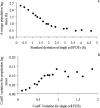Single-cell and population lag times as a function of cell age
- PMID: 18296533
- PMCID: PMC2293159
- DOI: 10.1128/AEM.02402-07
Single-cell and population lag times as a function of cell age
Abstract
After inoculation, the times to the first divisions are longer and more widely distributed for those Escherichia coli single cells that spent more time in the stationary phase prior to inoculation. The second generation times are still longer than the typical generation times in the exponential phase, and this extended the apparent lag time of the cell population. The greater the variability of the single-cell interdivision intervals, the shorter are both the lag time and the doubling time of the population.
Figures




References
Publication types
MeSH terms
LinkOut - more resources
Full Text Sources
Other Literature Sources

